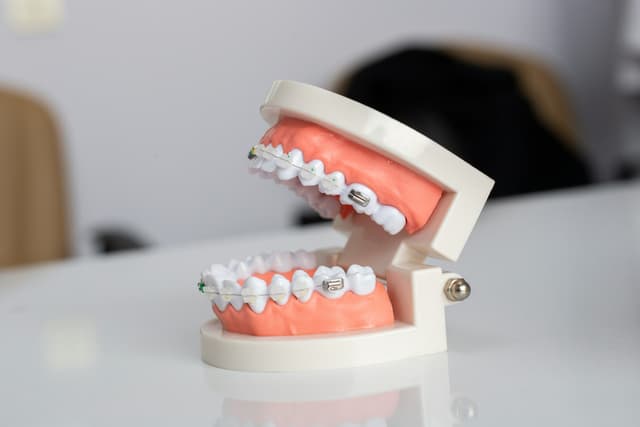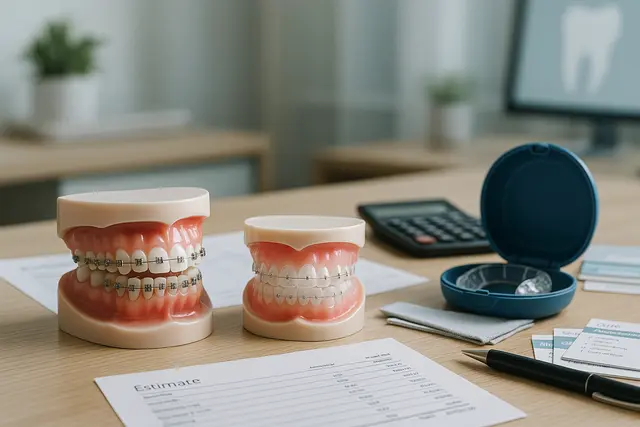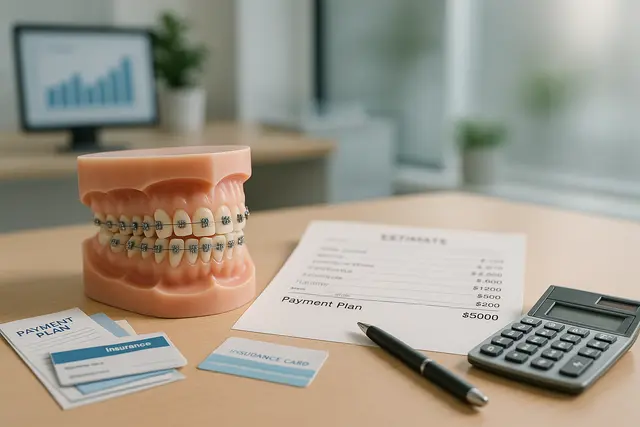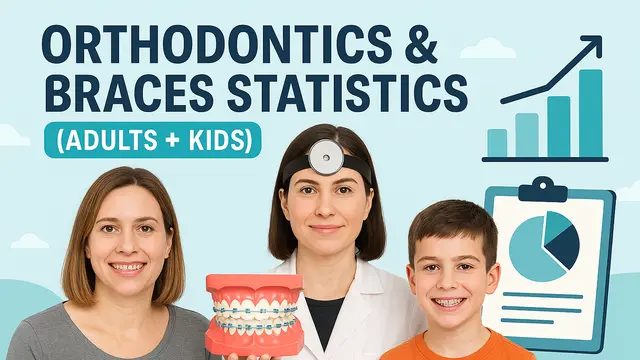Orthodontics
5 min read
Jan 23, 2025
The Different Types of Braces: Traditional, Ceramic, and Lingual
Orthodontic treatments come with several options tailored to meet different needs and preferences. Understanding your options is key to selecting the braces that fit your lifestyle and goals.

Crowded or misaligned teeth can make anyone self-conscious at weddings, first dates, and Zoom calls. The good news? Today, there are several different types of braces available, and each one coaxes every tooth into line while fitting different needs and preferences.
This article breaks down the main types of orthodontic gear, traditional metal braces, ceramic braces, and lingual braces, then touches on clear aligners and the clever world of self-ligating brackets. By the end, you’ll know which type of braces might suit your smile, your schedule, and your wallet. For more information, check our website at RankMyDentist. Consult a dentist on our website to learn more about braces.
Type of Braces
Modern orthodontics offers more variety than ever before. Today, braces can be grouped into two main types.
Fixed appliances that stay in place and cannot be removed
Removable trays that can be taken out when needed.
All rely on steady pressure on the teeth to move them through bone remodeling, yet each appliance feels and looks different. Because there are so many types of brace options, choosing the right orthodontic partner matters almost as much as picking the right color for your elastic ties.
Traditional Metal Braces
Ask any orthodontist about the workhorse of their practice, and they’ll point to traditional metal braces.
These braces consist of tiny metal brackets bonded to the teeth in the front and a springy wire that threads through each bracket.
Elastic bands to hold that wire come in every shade from neon green to white.
Metal brackets and wires are tough, inexpensive, and braces are just as effective for mild to moderate dental crowding as they are for complex jaw corrections.
Because metal braces require regular adjustments, most patients visit every four to six weeks so the orthodontist can tighten things and keep the teeth moving on schedule.
Braces are applied in about an hour, and the initial tenderness proves the braces work.
Yes, they’re shiny, but traditional braces alternatives like lingual sets offer unbeatable control over each tooth and cost less time.
Ceramic Braces
If you need braces yet dread that full-metal smile, ceramic braces might be your happy medium.
Their ceramic brackets blend with enamel, so ceramic braces are less noticeable in selfies and office meetings.
The device uses the same brackets and wires strategy, ceramic braces function similarly to steel, just with a lighter hue.
Be aware that ceramic brackets are larger and chip-prone, and the ceramic material can bump the fee a notch expensive than traditional braces.
Still, many adults decide the trade-off is worth it because these braces are less visible and still move the teeth efficiently. Orthodontists often reserve them for mild to moderate dental cases because friction is higher, but in the same way as metal braces, they straighten tooth after tooth with reliable predictability.
Lingual Braces
Flip classic hardware upside-down and you get lingual braces.
Each custom bracket bonds to the backside of the teeth, so the system hides behind the teeth.
A contoured wire threads across the back of the teeth, urging each tooth into perfect formation while staying virtually invisible. Because lingual braces are attached to the inside of the teeth.
They’re popular with actors, public speakers, and anyone who wants to straighten teeth on the sly.
Expect a brief lisp while your tongue makes friends with the hardware, and know that lingual sets are often more expensive than traditional braces.
Still, for adults who want to straighten their teeth without broadcasting treatment, they can’t be beat.
They even shield their lips from sports impacts because everything stays hidden behind the teeth.
Self-Ligating Braces
Traditional brackets rely on colored ties, but self-ligating braces change the game.
Self-ligating braces use tiny spring-loaded doors, self-ligating braces use a built-in clip, that hold the wire in place instead of elastic bands.
Less friction can let teeth into desired positions faster, and shorter chair visits make life easier for parents juggling soccer practice.
Self-ligating braces are an excellent option for people who dislike swapping stained elastics. Though research is mixed on speed, many patients report lighter forces and smoother sliding, which their gums, and each sore tooth, appreciate.
Clear Aligners and Other Removable Helpers
For readers dreaming of zero brackets, clear aligners deliver.
These removable plastic trays snap over each tooth and are replaced every two weeks so the new set can nudge each tooth further.
They’re best used to straighten teeth with mild crowding; rotated canines sometimes need traditional metal braces backup. Forgetting to wear trays slows progress, so aligners suit disciplined adults more than snack-happy teens.
Because no metal or ceramic parts cling to enamel, brushing and flossing stay simple, an under-celebrated perk for long-term dental care.
Choosing the Right Type
Choosing the right type of braces comes down to lifestyle, bite complexity, and bank balance. If cost wins, stick with metal or ceramic braces, they’re proven and budget-friendly. If cameras rule your calendar, ceramic braces or lingual braces are less conspicuous. If shorter appointments matter, the clip system of self-ligators shines.
And if floss freedom is non-negotiable, aligners might be the right braces for you. Your orthodontist will weigh X-rays, jaw growth, and how many millimeters each stubborn tooth must travel before recommending the right type of braces.
Orthodontic Treatment
Most patients start orthodontic treatment with scans, moulds, and photos that let the doctor map how each tooth must pivot. Once hardware goes on, you’ll feel gentle pressure on the teeth for a day or two, perfectly normal. Adjustments come monthly, and tiny elastic bands may refine bite fit. After the grand reveal, a retainer keeps teeth from shifting back. Think of it as insurance for all that hard work.
How Braces Provide Real-World Benefits
Beyond boosting confidence, braces provide serious health perks. Proper spacing makes each tooth easier to clean, reducing cavities and gum disease risk. Aligned bites lessen uneven enamel wear and can even calm jaw-joint headaches. So while braces are applied for cosmetic sparkle, they often end up improving airway function, chewing power, and long-term oral comfort.
Wrapping It Up
There are many types of dental braces, each with its own quirks, but all aim to guide every misbehaving tooth into glorious order. Whether you lean toward traditional metal braces, sleek ceramic braces, stealthy lingual braces, high-tech self-ligating braces, or Invisalign-style trays, today’s orthodontic toolbox makes it possible to straighten the teeth without sacrificing personality, or lunchtime burritos.
Plus, with trusted dental professionals available in RankMyDentist, including major cities like Las Vegas, New York, and Washington, you’re never far from expert care.
What Are the Main Types of Braces Available Today?
The primary types of braces include traditional metal braces, ceramic braces, lingual braces, self-ligating braces, and clear aligners. Each option works by gradually moving teeth using controlled pressure, but they differ in appearance, comfort, maintenance, and cost. Your choice depends on lifestyle, treatment needs, and personal preference.
How Do Self-Ligating Braces Differ From Traditional Braces?
Self-ligating braces use a built-in clip instead of elastic bands to hold the wire in place. This design reduces friction and may shorten treatment time while making adjustments quicker and more comfortable. They're often chosen by patients who want easier hygiene and fewer orthodontic visits.
Are Clear Aligners as Effective as Braces?
Clear aligners are effective for mild to moderate alignment issues. They’re discreet, removable, and easier to clean around than braces. However, they require consistent wear, about 20 to 22 hours a day, and may not be suitable for complex cases that require more precise tooth movement.
Which Type of Braces Is Best for Adults Who Want a Discreet Option?
For a low-visibility treatment, adults often choose ceramic braces, which blend with natural teeth, or lingual braces, which are attached to the back of the teeth. Clear aligners like Invisalign are also popular because they’re virtually invisible and removable for eating and cleaning.
Read Next
Related Posts

Orthodontics
Retainer That Looks like Braces: Benefits for Long-Term Alignment
A retainer might not get as much attention as braces, but it plays a crucial role in maintaining your smile after orthodontic treatment. Whether you're new to retainers or curious about the type that looks like braces, understanding their purpose and benefits is key to keeping your teeth aligned for the long haul.
6 min read
Sep 15, 2025

Orthodontics
How Much Are Metal Braces? Cost Comparison With Other Options
Thinking about getting braces but overwhelmed by the cost? You’re not alone. Orthodontic treatment can be a major investment, and understanding the different price points, from metal braces to clear aligners, can help you make a smart, confident decision.
5 min read
Sep 15, 2025

Orthodontics
Orthodontics & Braces Statistics (Adults + Kids)
Orthodontics has transformed from a niche medical service for teenagers into a booming sector that spans all ages. Today, both adults and children seek orthodontic treatment to improve their smiles, fix bite issues, and boost self-confidence.
4 min read
Aug 21, 2025
Don’t have time to research every dentist around you?
See why 30k+ patients trusted us